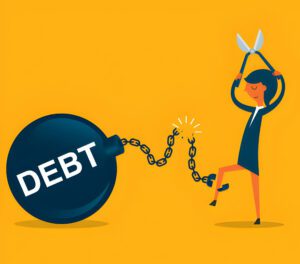Debt review removal is a legal process that helps over-indebted consumers to restructure their debt and pay it off in a more affordable way. It also protects them from legal action by creditors and prevents them from taking on more debt. However, some consumers may want to exit debt review for various reasons, such as improving their credit score, applying for a home loan, or starting a business.
According to the National Credit Regulator, there were about 10 million credit-active consumers in South Africa who had impaired credit records as of June 2023. This means that they were either in arrears, under debt review, or had adverse listings or judgments against them. These consumers face many challenges, such as high interest rates, limited access to credit, and reduced financial freedom.
In this post, we will discuss the legal ways to exit debt review removal in South Africa, based on the National Credit Act and the recent court decisions. We will also explain the pros and cons of each option and the criteria to qualify for them. Finally, we will provide some practical advice for consumers who want to exit debt review and avoid unethical or illegal service providers.
Debt Review Removal
There are three main ways to exit debt review in South Africa, depending on your financial situation and the stage of your debt review process. These are:
Paying off all your debt: This is the simplest and most effective way to exit debt review. If you manage to pay off all your debt, including your home loan, you can apply for a clearance certificate from your debt counsellor. This certificate will confirm that you have fulfilled all your obligations under debt review and that you are no longer over-indebted.
Your debt counsellor will then notify the credit bureaus and the National Credit Regulator, and your credit profile will be updated accordingly. This option has the advantage of improving your credit score and restoring your creditworthiness. However, it may take a long time and a lot of money to achieve this, especially if you have a large home loan or other long-term debt.
Paying off all your unsecured debt: This is a more realistic option for many consumers who are under debt review. If you manage to pay off all your unsecured debt, such as credit cards, personal loans, and store accounts, you can apply for a partial clearance certificate from your debt counsellor. This certificate will confirm that you have paid off all your unsecured debt and that you are no longer over-indebted, except for your home loan.
Your debt counsellor will then issue a Form 19 to terminate your debt review and notify the credit bureaus and the National Credit Regulator. Your credit profile will be updated accordingly, and you will be able to access credit again, except for a home loan. This option has the advantage of allowing you to exit debt review sooner and regain some financial freedom. However, it also has some drawbacks, such as exposing you to the risk of falling into debt again, losing the protection of debt review, and having to pay your home loan at the original terms and interest rate.
Applying for a court order: This is the most controversial and complicated way to exit debt review. If you believe that your financial situation has improved significantly and that you can afford to pay your debt at the original terms and interest rate, you can apply for a court order to exit debt review. You will need to prove to the court that you are no longer over-indebted and that you can honour your debt obligations without debt review. You will also need to notify your debt counsellor and your creditors of your intention to exit debt review and give them an opportunity to object. If the court grants your application, your debt review will be terminated and your credit profile will be updated accordingly.
However, this option has many disadvantages, such as being costly, time-consuming, and risky. You may face legal challenges from your debt counsellor or your creditors, who may argue that you are still over-indebted or that you have breached your debt review agreement. You may also lose the benefits of debt review removal, such as lower interest rates, reduced monthly payments, and protection from legal action. Furthermore, you may damage your relationship with your debt counsellor and your creditors, who may see your attempt to exit debt review as a sign of bad faith or dishonesty.
Examples and Case Studies of Debt Review Removal
To illustrate the different ways to exit debt review in South Africa, let us look at some examples and case studies of consumers who have successfully or unsuccessfully done so.
Example 1: John was under debt review since 2020, when he had a total debt of R500,000, including a home loan of R300,000. He was paying R10,000 per month towards his debt, at a reduced interest rate of 15%. In 2024, he received a large inheritance of R400,000, which he used to pay off all his debt, except for his home loan. He then applied for a clearance certificate from his debt counsellor, who issued it within 10 days. His debt counsellor also notified the credit bureaus and the National Credit Regulator, and his credit profile was updated accordingly. John was able to exit debt review by paying off all his debt, and he improved his credit score and restored his creditworthiness.
Example 2: Mary was under debt review since 2021, when she had a total debt of R200,000, including a home loan of R100,000. She was paying R5,000 per month towards her debt, at a reduced interest rate of 12%. In 2024, she received a promotion at work, which increased her income by 50%. She then decided to pay off all her unsecured debt, such as credit cards, personal loans, and store accounts, which amounted to R80,000. She then applied for a partial clearance certificate from her debt counsellor, who issued it within 10 days. Her debt counsellor also issued a Form 19 to terminate her debt review and notified the credit bureaus and the National Credit Regulator. Her credit profile was updated accordingly, and she was able to access credit again, except for a home loan. Mary was able to exit debt review by paying off all her unsecured debt, and she regained some financial freedom.
See also: Loans for debt review clients
Free Debt Review Removal
There is no such thing as free debt review removal in South Africa. You will always have to pay some fees, either to a lawyer or to a debt counsellor, to exit debt review legally. Anyone who claims to offer free debt review removal is likely to be a scammer who will take your money and not deliver the service. You should be very careful and avoid such unethical or illegal service providers.
Conclusion
Debt review removal in South Africa is not an easy or straightforward process. It requires careful consideration of the legal implications, the financial consequences, and the personal circumstances of each consumer. There are three main ways to exit debt review in South Africa: paying off all your debt, paying off all your unsecured debt, or applying for a court order.
Each option has its pros and cons, and its criteria to qualify. Therefore, it is advisable to seek professional guidance from a reputable debt counsellor or a legal expert before attempting to exit debt review.
It is also important to avoid unethical or illegal service providers who may promise to remove you from debt review without following the proper procedures or complying with the law. Remember, debt review is not a punishment, but a solution to help you overcome your debt problems and achieve financial stability.


